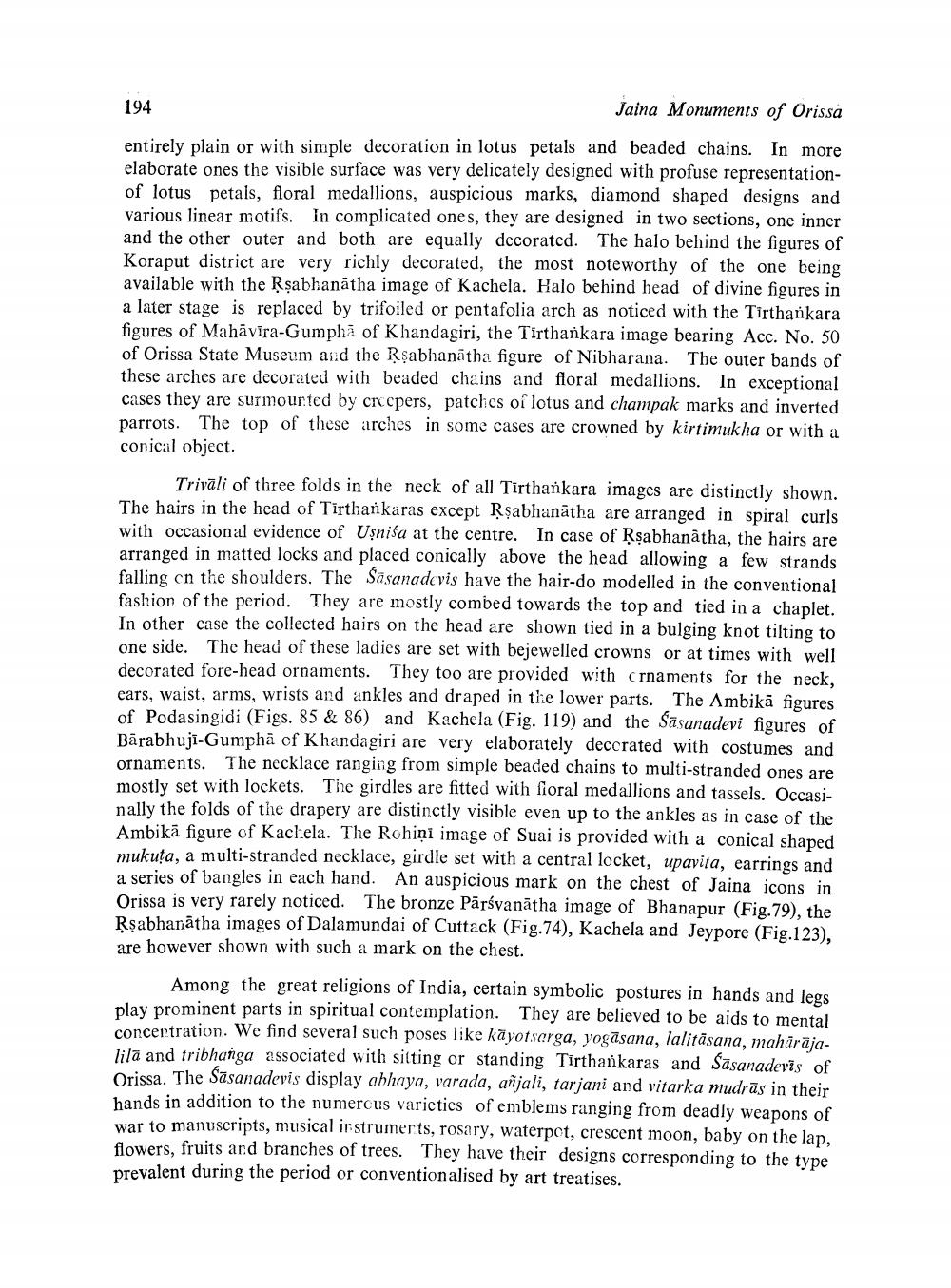________________
194
Jaina Monuments of Orissa
entirely plain or with simple decoration in lotus petals and beaded chains. In more elaborate ones the visible surface was very delicately designed with profuse representationof lotus petals, floral medallions, auspicious marks, diamond shaped designs and various linear motifs. In complicated ones, they are designed in two sections, one inner and the other outer and both are equally decorated. The halo behind the figures of Koraput district are very richly decorated, the most noteworthy of the one being available with the Rşabhanātha image of Kachela. Halo behind head of divine figures in a later stage is replaced by trifoiled or pentafolia arch as noticed with the Tirthankara figures of Mahāvīra-Gumphā of Khandagiri, the Tirthankara image bearing Acc. No. 50 of Orissa State Museum and the Rşabhanātha figure of Nibharana. The outer bands of these arches are decorated with beaded chains and floral medallions. In exceptional cases they are surmourted by crccpers, patches of lotus and champak marks and inverted parrots. The top of these arches in some cases are crowned by kirtimukha or with a conical object.
Triväli of three folds in the neck of all Tirthankara images are distinctly shown. The hairs in the head of Tirthankaras except Rşabhanātha are arranged in spiral curls with occasional evidence of Uşnisa at the centre. In case of Rşabhanatha, the hairs are arranged in matted locks and placed conically above the head allowing a few strands falling on the shoulders. The Sasanadcvis have the hair-do modelled in the conventional fashion of the period. They are mostly combed towards the top and tied in a chaplet. In other case the collected hairs on the head are shown tied in a bulging knot tilting to one side. The head of these ladies are set with bejewelled crowns or at times with well decorated fore-head ornaments. They too are provided with crnaments for the neck, ears, waist, arms, wrists and ankles and draped in the lower parts. The Ambikā figures of Podasingidi (Figs. 85 & 86) and Kachela (Fig. 119) and the Sāsanadevi figures of Bärabhuji-Gumphä сf Khandagiri are very elaborately decorated with costumes and ornaments. The necklace ranging from simple beaded chains to multi-stranded ones are mostly set with lockets. The girdles are fitted with fioral medallions and tassels. Occasinally the folds of the drapery are distinctly visible even up to the ankles as in case of the Ambikā figure of Kachela. The Rohiņi image of Suai is provided with a conical shaped mukuta, a multi-stranded necklace, girdle set with a central locket, upavita, earrings and a series of bangles in each hand. An auspicious mark on the chest of Jaina icons in Orissa is very rarely noticed. The bronze Pārsvanātha image of Bhanapur (Fig. 79), the Rsabhanātha images of Dalamundai of Cuttack (Fig. 74), Kachela and Jeypore (Fig.123), are however shown with such a mark on the chest.
Among the great religions of India, certain symbolic postures in hands and legs play prominent parts in spiritual contemplation. They are believed to be aids to mental concentration. We find several such poses like käyotserga, yogāsana, lalitäsana, mahārājalila and tribhanga associated with sitting or standing Tirthankaras and Sāsanadevās of Orissa. The Sāsanadevis display abhaya, varada, anjali, tarjani and vitarka mudrās in their hands in addition to the numerous varieties of emblems ranging from deadly weapons of war to manuscripts, musical instruments, rosary, waterpot, crescent moon, baby on the lap, flowers, fruits and branches of trees. They have their designs corresponding to the type prevalent during the period or conventionalised by art treatises.




